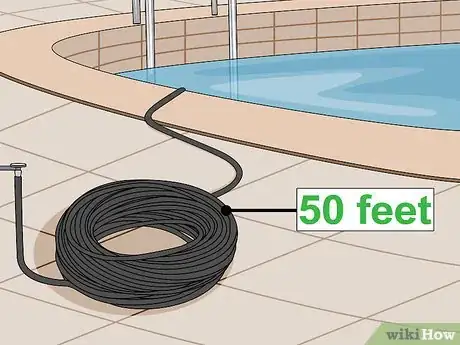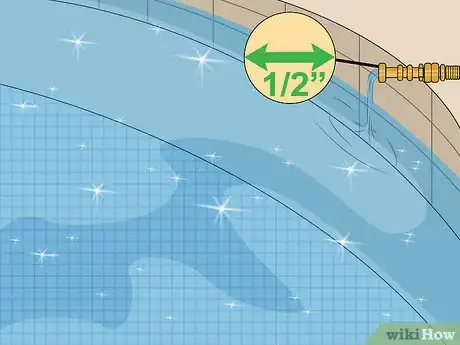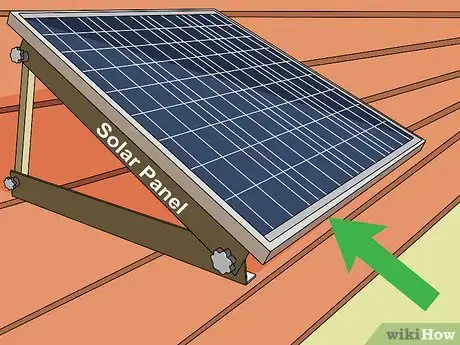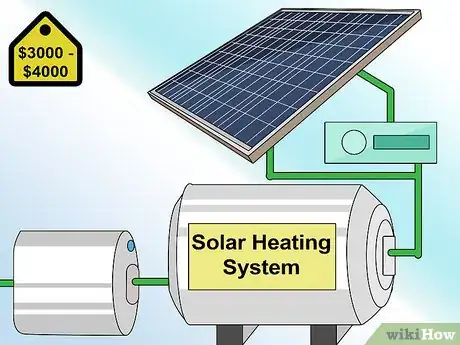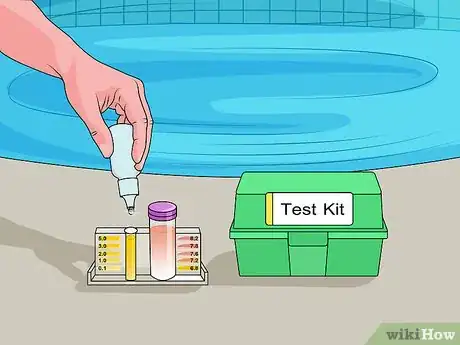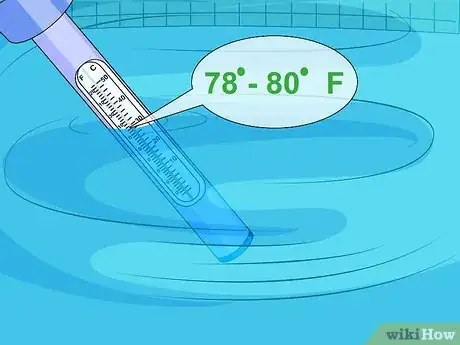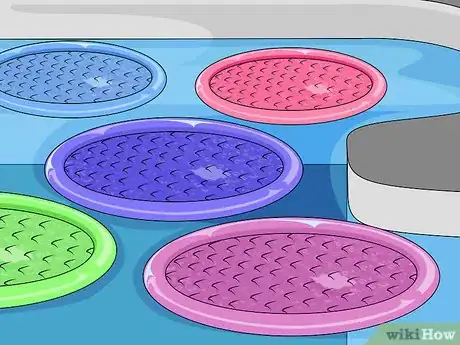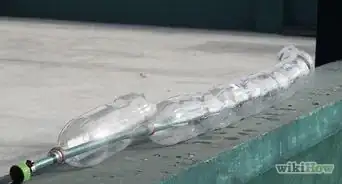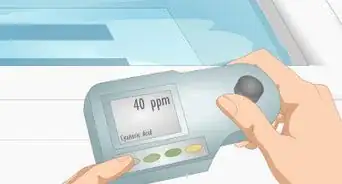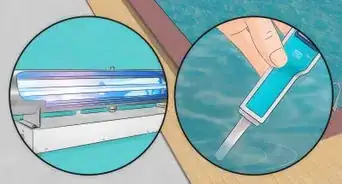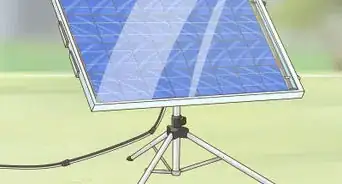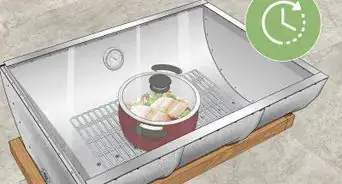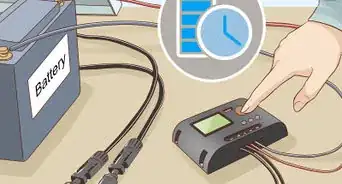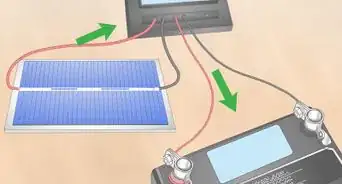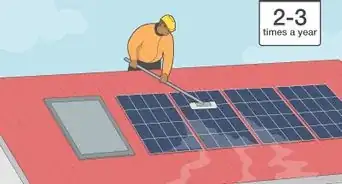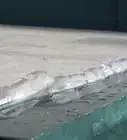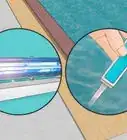This article was co-authored by Guy Gabay and by wikiHow staff writer, Amber Crain. Guy Gabay is a Solar Energy Contractor and the CEO of AmeriGreen Builders, a full-service solar energy, roofing, HVAC and window installation company based in the greater Los Angeles, California region. With over eight years of experience in the construction industry, Guy leads the AmeriGreen team focusing on bringing an educational approach to energy efficient home upgrades. Guy holds a B.S. in Marketing from California State University - Northridge.
This article has been viewed 332,411 times.
Heating and maintaining a swimming pool can be very costly. This expense can be significantly reduced by using solar energy. There are numerous solar energy options available, and the success you have using it will depend on your climate, the size of your pool and the way you choose to heat your water. If installing a full solar heating system is not feasible for you, there are many other solar options you can implement that are easier and far less expensive.
Steps
Filling Your Pool
-
1Use a long, dark-colored hose to fill up your pool.[1] The longer it takes for water to make its way through the hose and into your pool, the warmer that water will be. While fifty feet of hose is generally sufficient, additional length means the water will have even more time to warm up. The added surface area of the hose collects more heat, as well. If you use a dark-colored hose, the water can get even warmer because dark colors absorb more solar energy.
- A black rubber hose is ideal and relatively inexpensive. You can also use a black garden irrigation pipe, because it’s thin walls allow for a faster heat transfer. While it is inexpensive, it will also kink easily.
- Both of these are available in most home supply stores.
-
2Make sure the hose is in direct sunlight.[2] When filling your pool, make sure the hose gets full sun exposure to absorb as much energy as possible. Point the hose directly towards the sun or mount your hose on a board that can be angled toward the sun for even more exposure.
- You may want to consider mounting the hose on a board and attach it to a sun-facing roof. This is not recommended unless you have a suitable low roof, such a shed, or are skilled at working at roof height.
Advertisement -
3Fill the pool slowly with a thin hose.[3] A thinner stream of water will heat more quickly when filling your pool. Use a hose that is ⅝ or ½ inch in diameter to slowly fill the pool. Try keeping the stream around half an inch in diameter to allow it to take in heat while still filling the pool at a decent rate.
- Always fill up your pool on a sunny day to take the most advantage of the sun’s energy.
Heating Your Pool
-
1Use a solar blanket. Solar blankets are pool covers designed to soak up solar energy and transfer it directly into the water. These covers can help increase water temperature by about 5°F for every 12 hours of coverage.[4] Solar blankets also insulate the surface of your pool, which prevents the heat from escaping. A transparent or nearly transparent solar blanket works best.[5]
- Just like a regular pool cover, solar blankets also minimize water evaporation, which conserves energy.
- They also prevent debris from getting into your pool and minimize the amount of chemicals needed to treat the water.
-
2Use solar rings. These clear, inflatable disks float on the surface of your pool and heat the water. One ring transfers up to 21,000 BTU a day. A ring is generally 59 inches in diameter, so buy enough rings to cover approximately 80% of your pool. Rings will generally last five years and cost up to twenty dollars each. However, considering that they don’t use any electricity, this is a moderate cost.
- Another advantage of solar rings is that they are easy to remove and disassemble for winter storage.
- Rings can be left on your pool while the cover is being used.
-
3Mount solar panels on the roof of your home.[6] These panels collect heat from the sun to warm pool water. They are easy to install and quite durable in all climates. You can get glazed or unglazed solar collectors. The unglazed panels are less expensive but also slightly less effective in producing heat.
- However, the unglazed versions are efficient as long as you don’t want to use your pool when temperatures are below freezing.
- If you live in a warm, sunny climate, these panels are an ideal solution.
- Solar panels are made up of photovoltaic cells, which sun's energy into something you can use.[7]
-
4Install a solar heating system.[8] These systems include a solar collector, a filter, a pump and a flow control valve. Water is pumped through the filter and then through the collector, which heats it before returning it to the pool. They are an excellent solution, but expensive. A solar heating system will cost between $3,000 and $4,000 to buy and install.
- The system should last up to seven years.
- They are generally more effective than gas and heat pump heaters. They tend to last longer, too.
Preventing Energy Loss
-
1Maintain your pool.[9] The pump and circulation systems must be kept in good condition to get the most out of your solar collectors. Routinely check to make sure the filter is effectively cleaning debris from your pool. Keep the drain systems clear of debris to allow the water to flow freely and easily. Check the pump frequently to confirm water is circulating properly.
- Use pool water test kits to maintain the proper pH and chlorine levels.
- When chemicals need to be added, do it as far from the collector intake pipes as possible.
-
2Watch the water temperature. The correct range for recreational use is 82-84°F and 78-80°F for more active swimming. If your temperatures are far above that, you are probably wasting energy. Buy a pool thermometer to help you monitor the temperature and reduce the pump speed when the water becomes too hot.[10]
-
3Use a solar blanket whenever the pool isn’t in use. Evaporation is responsible for the greatest loss of energy in pools. To prevent energy from being lost, keep the solar cover on the pool whenever it isn’t in use. The solar blanket will continue to collect energy from the sun and heat the water, while also preventing the heat from escaping.[11]
- Pool covers block debris from entering the pool, which will reduce the pool’s cleaning time and chemical consumption.
References
- ↑ http://greenterrafirma.com/diy-solar-pool-heater.html
- ↑ http://greenterrafirma.com/diy-solar-pool-heater.html
- ↑ http://greenterrafirma.com/diy-solar-pool-heater.html
- ↑ http://greenterrafirma.com/diy-solar-pool-heater.html
- ↑ http://www.fsec.ucf.edu/En/consumer/solar_hot_water/pools/q_and_a/index.htm#Cover
- ↑ http://www.blueworldpools.com/pool-faq.html
- ↑ Guy Gabay. Solar Energy Contractor. Expert Interview. 4 August 2020.
- ↑ http://energy.gov/energysaver/solar-swimming-pool-heaters
- ↑ http://www.fsec.ucf.edu/En/consumer/solar_hot_water/pools/q_and_a/index.htm#Cover
About This Article
Using solar energy to heat your pool is a great way to save money on your bills and reduce your carbon footprint. One simple way is to cover your pool with a solar blanket, which soaks up heat from the sun and transfers it to the water. These can help increase water temperature by about 5 degrees Fahrenheit for every 12 hours of coverage. You can also get solar rings, which work the same way as a pool cover and cost about $20 each. Rings float on your pool’s surface, so you can use them at the same time as a pool cover if you'd like. If you’re willing to make a big investment, consider installing a solar heating system, which generates electricity from solar panels, then heats and filters your pool water. These generally cost 3,000 to 4,000 dollars and should last up to 7 years. For more tips, including how to minimize the energy your pool uses, read on!
